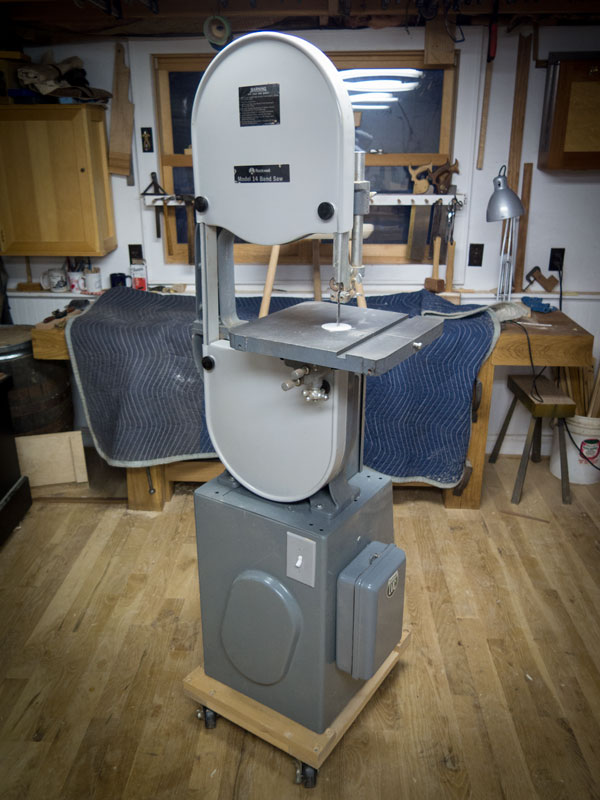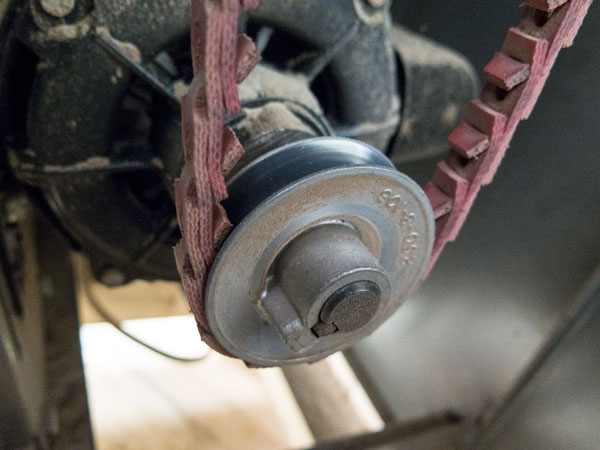We may receive a commission when you use our affiliate links. However, this does not impact our recommendations.
When the history of 20th-century woodworking machinery is written, someone will compose a poem, ode or opera to the Delta 14” band saw that was made in the United States.
There are many flavors of this band saw depending on who owned Delta at the time the machine was made, and machinery collectors make fine distinctions about which era was the best. But for users, I think the decision is simple: If it’s a Delta 14” band saw that was made in the United States, it’s worth owning. Here’s why:
Delta made so many of these band saws that the world will likely never run out of them – much like the Stanley Bailey No. 5 plane. Because they are common, they are generally inexpensive. I bought my 1980-vintage Rockwell Delta saw for $275.
Most accessories fit the Delta band saw – heck, most accessories were designed with this saw in mind. The blade that the machine uses is the most common length – you’ll always find one on the rack at a woodworking store and I can usually find them at home centers. If you ever need parts for your saw, they are cheap and easy to get.
But most of all, the saw is built like a tank. It is not fussy or difficult to tune. And its overall design is so perfect that it was the model that Asian manufacturing plants began copying in the late 20th century, which eventually contributed to the constriction of Delta’s U.S.-based manufacturing efforts.
So if you buy one of these saws (or own one already), how should you soup it up?
To be honest, I don’t think you should do much at all. When I add accessories to a machine, I avoid things that increase its complexity. The more complex the machine, the more that can go wrong. So I use the stock blade guides, including the old metallic side guides (I love them). I don’t have a fence. I haven’t even added any dust collection ports.
The machine runs like a champ with the stock equipment. My blades never heat up. And I have all the control I want when cutting. But I have changed a few things, and they are all inexpensive upgrades.
I put in an aftermarket zero-clearance throat insert, a $5 upgrade. This prevents small offcuts from getting wedged between the blade and throat insert. The main tension spring on my saw wore out (35 years is a good run). So I replaced it with an aftermarket spring. And I replaced the original belt with one of the red Power-Twist V-belts. Those do make a difference on machinery. In fact, I run this saw with an old 1/4-horsepower U.S.-made motor from the 1950s and the saw has never stalled or felt underpowered, even in resawing 6”-thick material.
Lastly, I use good blades. For most operations I recommend the Woodslicer blades from Highland Woodworking. I’ve tried a lot of blades, and these are my favorite. (I also use the Lenox carbide blades, but I don’t recommend those for new band saw users – a small misalignment of your guides will ruin a $200 blade in nothing flat.)
There are lots of amazing band saws made today that eclipse the old Deltas in their cutting capacity, raw power and fine adjustments. But nothing can beat the Delta’s utility, flexibility and overall value.
— Christopher Schwarz
Here are some supplies and tools we find essential in our everyday work around the shop. We may receive a commission from sales referred by our links; however, we have carefully selected these products for their usefulness and quality.












I fondly remember using this Delta 14” band saw when I was a pattern maker back in the 60s. Now that I am getting back into woodworking as a hobby, I would love to find one these models as good as the one you have pictured. However on ebay they are listing worn out examples for 2-3 times what you paid. Any recommendation where to locate one like yours, would be greatly appreciated. Thanks for the inspiring articles. Danny
Chris
How can I definitely tell if the used one I’m looking at was made in USA?
I agree with your comments on all points regarding the saws even though mine was made in China. However, since the latest owners have taken over, parts, and perhaps the saws, are not readily available (or perhaps not at all) in Canada. Making matters worse, the manufacturer does not ship to Canada.
Ditto on all points. I bought my 1980s vintage for $500 fifteen years ago and it was virtually unused and included a mobile base too. I like the WoodSlicers but I really like my Lenox carbide. I also upgraded mine with the height extension, a 2hp motor (yes, it fits), those itty-bitty roller guides and the link belt. It cuts hard maple faster than my Powermatic 66 and with a cleaner cut. Not sure what else I could do to it to make it better. Carter’s guides?
For sure, if sea levels rise here in FL, I’ll add outriggers and a floatation ring ’cause it’s coming with me!
cheers all,
Chris,
You said 1/4 HP motor?
Did you mean something else?
I have a 1 hp on mine and while I never stalled it, it is obvious when I am overworking the machine…
Regardless, I agree with the statements – “Must-have, workhorse, good-to-go without (many) upgrades etc. etc. etc.”
Those 14’s are great for circle and curve cutting with your finer band saw blades, Not so much with resaw where they are limited to 6″ without a riser block, and underpowered. Yes you can resaw, but it takes a lot of time, and patience to do so. This is the reason so many woodworkers are keeping the old 14 for curvy work, and buying a second band saw for just resaw. Bigger capacity, wider wheels allowing for a wider blade, the blades are thicker, and offer special tooth sets like 1.3 teeth per inch so there is an actual gullet buried in the wood, and you maintain 3 teeth working on the cut. But mostly power to drive all this action so you don’t have birthdays waiting for a wide board to become 2 or more thinner versions. Those of us with 2 band saws aren’t giving up either of them 🙂
You make a good point about the availability of parts. A friend of mine bought a “Central Machinery” saw. Every time something broke, he replaced the broken part with a used Delta part purchases on E-bay. Surprisingly few parts broke, but none broke twice. Seems like the only place this approach wouldn’t work would be the lower blade guides, but there you could go with Jet parts. I’m not advocating this approach, mind you. Just sayin’.